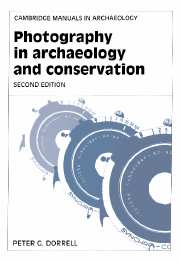Book contents
- Frontmatter
- Contents
- List of illustrations
- Preface
- Preface to the second edition
- Acknowledgements
- 1 The early days of archaeological photography
- 2 Basic principles and practice
- 3 Equipment
- 4 Lighting by flash
- 5 Photographic materials, processing and printing
- 6 Architecture and standing monuments
- 7 Survey photography
- 8 Site photography
- 9 Principles of object photography
- 10 Principles of close-up photography
- 11 Ultra-violet and infra-red photography
- 12 Photographing finds
- 13 Flat copy
- 14 Preparation of material for publication
- 15 The future
- References
- Index
1 - The early days of archaeological photography
Published online by Cambridge University Press: 23 December 2009
- Frontmatter
- Contents
- List of illustrations
- Preface
- Preface to the second edition
- Acknowledgements
- 1 The early days of archaeological photography
- 2 Basic principles and practice
- 3 Equipment
- 4 Lighting by flash
- 5 Photographic materials, processing and printing
- 6 Architecture and standing monuments
- 7 Survey photography
- 8 Site photography
- 9 Principles of object photography
- 10 Principles of close-up photography
- 11 Ultra-violet and infra-red photography
- 12 Photographing finds
- 13 Flat copy
- 14 Preparation of material for publication
- 15 The future
- References
- Index
Summary
As with many scientific advances, photography was the result of the coming together of discoveries in several countries and the application of principles of physics and chemistry long known but not previously put to practical use.
The history of photography is well documented (e.g. Jeffrey (1981); a comprehensive account of early archaeological photography, especially in France, is given in Feyler (1987)), and there is no need to recount it in any detail here, nor to try to assess the claims that have been made for national priorities. Briefly, by 1838 L. J. Daguerre in France had developed a workable process for recording an image on silver-plated copper sheets; and by 1841 W. H. Fox Talbot in England had patented his ‘Calotype’ process whereby a negative image on silver chloride-impregnated paper was contact printed to give a positive image on a sheet of similar paper. In 1851 F. Scott Archer published an account of his invention of the collodion process, which made possible the use of a glass plate rather than a paper or metal base, thus increasing the effective speed and the range of tones of negatives. The plates had to be coated and used immediately, while still wet, a great inconvenience in field photography, and it was not until the 1870s that a reliable system of using bromide–gelatine emulsions – the dry plate – became available.
Photography began to be used for the recording of antiquities surprisingly early. In this country, Fox Talbot – himself an antiquarian, among many other things – took photographs of manuscripts, engravings and busts.
- Type
- Chapter
- Information
- Photography in Archaeology and Conservation , pp. 1 - 7Publisher: Cambridge University PressPrint publication year: 1994



